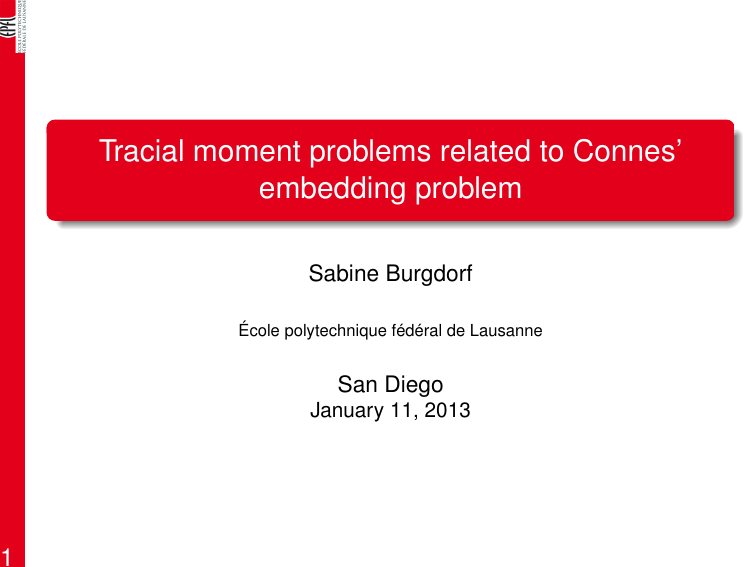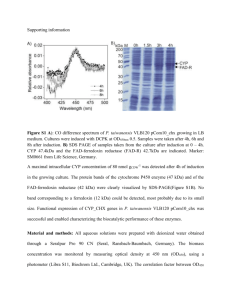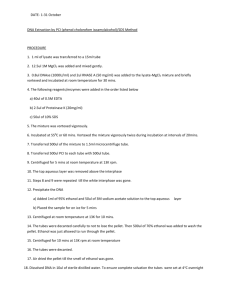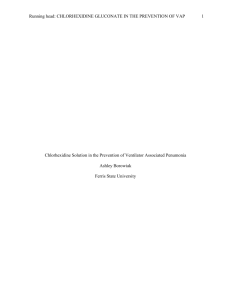Tracial moment problems related to Connes’ embedding problem 1 Sabine Burgdorf
advertisement

1
Tracial moment problems related to Connes’
embedding problem
Sabine Burgdorf
École polytechnique fédéral de Lausanne
San Diego
January 11, 2013
2
Classical moment problem
I
Let K ⊆ Rn be closed.
Moment problem
Let L : R[x] → R be linear, L(1) = 1. Does there exist a probability
measure µ with supp µ ⊆ K such that for all f ∈ R[x]:
Z
L(f ) = f (a) dµ(a)?
2
Classical moment problem
I
Let K ⊆ Rn be closed.
Moment problem
Let L : R[x] → R be linear, L(1) = 1. Does there exist a probability
measure µ with supp µ ⊆ K such that for all f ∈ R[x]:
Z
L(f ) = f (a) dµ(a)?
Theorem (Riesz, Haviland)
Let K ⊆ Rn be non-empty and closed, L ∈ R[x]∨ . There exists a
measure µ supported on K such that
Z
L(f ) = f (a) dµ(a) for all f ∈ R[x]
if and only if L(p) ≥ 0 for all p ∈ R[X ] that are positive on K .
3
NC polynomials
I
X = (X1 , . . . , Xn ) non-commuting variables
I
ChX i unital associative algebra freely generated by X
I
NC polynomials:
f =
X
w
fw w, where w ∈ hX i, fw ∈ K
3
NC polynomials
I
X = (X1 , . . . , Xn ) non-commuting variables
I
ChX i unital associative algebra freely generated by X
I
NC polynomials:
f =
X
fw w, where w ∈ hX i, fw ∈ K
w
I
(anti-)involution ∗ : ChX i → ChX i s.t.
I
Xi self-adjoint
is complex conjugation on C
I ∗
3
NC polynomials
I
X = (X1 , . . . , Xn ) non-commuting variables
I
ChX i unital associative algebra freely generated by X
I
NC polynomials:
f =
X
fw w, where w ∈ hX i, fw ∈ K
w
I
(anti-)involution ∗ : ChX i → ChX i s.t.
I
Xi self-adjoint
is complex conjugation on C
I ∗
I
Evaluation in self-adjoint matrices
I
A = (A1 , . . . , An ) ∈ (SCs×s )n
I
f (A) = f1 1s + fX1 A1 + fX2 A2 + ... + fX 2 X3 X 3 A21 A3 A32 + ...
1
2
4
NC hypercube and quadratic module
I
The vN hypercube K is the set of all n-tuples of self-adjoint
contractions in a finite vN algebra
I
The matricial hypercube is
Kmat = {A | A ∈ (SCs×s )n for some s ∈ N, kAi k ≤ 1, i = 1 . . . , n}
4
NC hypercube and quadratic module
I
The vN hypercube K is the set of all n-tuples of self-adjoint
contractions in a finite vN algebra
I
The matricial hypercube is
Kmat = {A | A ∈ (SCs×s )n for some s ∈ N, kAi k ≤ 1, i = 1 . . . , n}
I
SChX i = {f ∈ ChX i | f ∗ = f } symmetric part of ChX i
Definition
The quadratic module of the hypercube is
X
X
M := {f ∈ ChX i | f =
hj∗ hj +
pij∗ (1 − Xi2 )pij , hj , pij ∈ ChX i}.
j
I
i,j
If f ∈ M then f (A) 0 for all A ∈ K
4
NC hypercube and quadratic module
I
The vN hypercube K is the set of all n-tuples of self-adjoint
contractions in a finite vN algebra
I
The matricial hypercube is
Kmat = {A | A ∈ (SCs×s )n for some s ∈ N, kAi k ≤ 1, i = 1 . . . , n}
I
SChX i = {f ∈ ChX i | f ∗ = f } symmetric part of ChX i
Definition
The quadratic module of the hypercube is
X
X
M := {f ∈ ChX i | f =
hj∗ hj +
pij∗ (1 − Xi2 )pij , hj , pij ∈ ChX i}.
j
I
I
i,j
If f ∈ M then f (A) 0 for all A ∈ K
P
Let U = {f ∈ ChX i | f = j (pj qj − qj pj ), pj , qj ∈ ChX i}
5
Connes’ embedding problem
Conjecture (Connes, 1976)
If ω is a free ultrafilter on N and F is a II1 factor with separable
predual, then F can be embedded into the ultrapower Rω .
5
Connes’ embedding problem
Conjecture (Connes, 1976)
If ω is a free ultrafilter on N and F is a II1 factor with separable
predual, then F can be embedded into the ultrapower Rω .
Theorem (Klep, Schweighofer, 2008)
Connes’ conjecture holds iff
the following is equivalent for all f ∈ ChX i:
(i) Tr(f (A)) ≥ 0 for all A ∈ Kmat ,
(ii) ∀ε ∈ R>0 : f + ε ∈ M + U.
6
CEP using convex cones
I
Convex cones: M + U and
P = {f ∈ ChX i | Tr(f (A)) ≥ 0 for all A ∈ Kmat }
6
CEP using convex cones
I
Convex cones: M + U and
P = {f ∈ ChX i | Tr(f (A)) ≥ 0 for all A ∈ Kmat }
I
CEP is equivalent to
P = (M + U)
6
CEP using convex cones
I
Convex cones: M + U and
P = {f ∈ ChX i | Tr(f (A)) ≥ 0 for all A ∈ Kmat }
I
CEP is equivalent to
P = (M + U)
I
This is equivalent to
P ∨ = (M + U)∨
I
C ∨ = {L : KhX i → K | L linear, L(p) ≥ 0 for all p ∈ C}
6
CEP using convex cones
I
Convex cones: M + U and
P = {f ∈ ChX i | Tr(f (A)) ≥ 0 for all A ∈ Kmat }
I
CEP is equivalent to
P = (M + U)
I
This is equivalent to
P ∨ = (M + U)∨
I
I
C ∨ = {L : KhX i → K | L linear, L(p) ≥ 0 for all p ∈ C}
Counter example for CEP?
Find p ∈ P and L ∈ (M + U)∨ s.t. L(p) < 0
7
How to describe P ∨ ?
Theorem (Riesz, Haviland)
∨ . There exists a
Let K 0 ⊆ Rn be non-empty and closed, L ∈ R[x]
R
measure µ supported on K 0 such that L(f ) = f (a) dµ(a) for all
f ∈ R[x] if and only if L(p) ≥ 0 for all p ∈ R[X ] that are positive on
K 0.
7
How to describe P ∨ ?
Theorem (Riesz, Haviland)
∨ . There exists a
Let K 0 ⊆ Rn be non-empty and closed, L ∈ R[x]
R
measure µ supported on K 0 such that L(f ) = f (a) dµ(a) for all
f ∈ R[x] if and only if L(p) ≥ 0 for all p ∈ R[X ] that are positive on
K 0.
I
Let L := {L : ChX i → C | L linear, L(U) = {0}}
I
Mmat := {L ∈ L | ∃s ∈ N, measure
µ : supp µ ⊆ K ∩ (SCs×s ) :
R
L(f ) = Tr(f (A) dµ(A) for all f ∈ ChX i}
MvN := {L ∈ L | ∃ a finite vN algebra N and A ∈ K ∩ N :
L(f ) = τ (f (A)) for all f ∈ ChX i}
7
How to describe P ∨ ?
Theorem (Riesz, Haviland)
∨ . There exists a
Let K 0 ⊆ Rn be non-empty and closed, L ∈ R[x]
R
measure µ supported on K 0 such that L(f ) = f (a) dµ(a) for all
f ∈ R[x] if and only if L(p) ≥ 0 for all p ∈ R[X ] that are positive on
K 0.
I
Let L := {L : ChX i → C | L linear, L(U) = {0}}
I
Mmat := {L ∈ L | ∃s ∈ N, measure
µ : supp µ ⊆ K ∩ (SCs×s ) :
R
L(f ) = Tr(f (A) dµ(A) for all f ∈ ChX i}
MvN := {L ∈ L | ∃ a finite vN algebra N and A ∈ K ∩ N :
L(f ) = τ (f (A)) for all f ∈ ChX i}
Question
Do we have P ∨ = Mmat or P ∨ = MvN ?
8
The tracial moment problem
(Matricial) tracial moment problem
For which L ∈ L exist some s ∈ N and a probability measure µ with
supp µ ⊆ K ∩ (SCs×s )n such that for all f ∈ ChX i:
Z
L(f ) = Tr(f (A)) dµ(A)?
8
The tracial moment problem
(Matricial) tracial moment problem
For which L ∈ L exist some s ∈ N and a probability measure µ with
supp µ ⊆ K ∩ (SCs×s )n such that for all f ∈ ChX i:
Z
L(f ) = Tr(f (A)) dµ(A)?
Tracial vN-moment problem
For which L ∈ L exist a finite vN algebra N and A ∈ KvN ∩ N such
that for all f ∈ ChX i
L(f ) = τ (f (A))?
8
The tracial moment problem
(Matricial) tracial moment problem
For which L ∈ L exist some s ∈ N and a probability measure µ with
supp µ ⊆ K ∩ (SCs×s )n such that for all f ∈ ChX i:
Z
L(f ) = Tr(f (A)) dµ(A)?
Tracial vN-moment problem
For which L ∈ L exist a finite vN algebra N and A ∈ KvN ∩ N such
that for all f ∈ ChX i
L(f ) = τ (f (A))?
I
s = 1: Classical moment problem on Rn
8
The tracial moment problem
(Matricial) tracial moment problem
For which L ∈ L exist some s ∈ N and a probability measure µ with
supp µ ⊆ K ∩ (SCs×s )n such that for all f ∈ ChX i:
Z
L(f ) = Tr(f (A)) dµ(A)?
Tracial vN-moment problem
For which L ∈ L exist a finite vN algebra N and A ∈ KvN ∩ N such
that for all f ∈ ChX i
L(f ) = τ (f (A))?
I
s = 1: Classical moment problem on Rn
Question
Do we have P ∨ = Mmat or P ∨ = MvN ?
9
Intermission: Tracial Hankel matrix
I
We can describe (M + U)∨ using tracial Hankel matrices:
I
Associate to L ∈ L the sesquilinear form
BL : ChX i × ChX i, (f , g) 7→ L(f ∗ g).
9
Intermission: Tracial Hankel matrix
I
We can describe (M + U)∨ using tracial Hankel matrices:
I
Associate to L ∈ L the sesquilinear form
BL : ChX i × ChX i, (f , g) 7→ L(f ∗ g).
Definition
The tracial Hankel matrix M(L), indexed by u, v ∈ hX i, is given by
M(L)u,v := L(u ∗ v ).
For g ∈ SChX i and L ∈ L the localizing matrix M[g, L] is given by
M[g, L]u,v := L(u ∗ gv ).
I
(M + U)∨ = {L ∈ L | M(L) 0, M[1 − Xi2 , L] 0 for all i}
10
One tracial Hankel matrix
Example
Consider KhX , Y i with basis (1, X , Y , X 2 , XY , YX , Y 2 , . . . );
2
L(1)
L(X )
L(Y )
L(X )
...
L(X ) L(X 2 ) L(XY ) L(X 3 ) . . .
M(L) =
L(Y ) L(YX ) L(Y 2 ) L(YX 2 ) . . .
..
.
..
.
..
.
..
.
..
.
L(1 − X 2 )
L(X − X 3 )
L(Y − X 2 Y )
...
3
2
4
L(X − X )
L(X − X )
L(XY − X 3 Y ) . . .
M[1 − X 2 , L] =
L(Y − YX 2 ) L(YX − YX 3 ) L(Y 2 − YX 2 Y ) . . .
..
..
..
..
.
.
.
.
11
Relation between Mmat and MvN
Theorem (B)
Let L ∈ L with
(i) M(L) 0
(ii) M[1 − Xi2 , L] 0 for all i = 1, . . . , n
(iii) rank M(L) = s < ∞.
Then L has a representing measure on K ∩ (SCs×s )n .
11
Relation between Mmat and MvN
Theorem (B)
Let L ∈ L with
(i) M(L) 0
(ii) M[1 − Xi2 , L] 0 for all i = 1, . . . , n
(iii) rank M(L) = s < ∞.
Then L has a representing measure on K ∩ (SCs×s )n .
Corollary (B)
Let L ∈ MvN . Then L ∈ Mmat if M(L) is of finite rank.
12
Relation of P ∨ and M?
Question
Do we have P ∨ = Mmat or P ∨ = MvN ?
13
Relation of P ∨ and M
I
PvN := {p ∈ ChX i | τ (p(A)) ≥ 0 for all A ∈ K }
Theorem (B)
Let L ∈ L. Then L ∈ MvN if and only if L(p) ≥ 0 for all p ∈ PvN , i.e.
∨ .
MvN = PvN
13
Relation of P ∨ and M
I
PvN := {p ∈ ChX i | τ (p(A)) ≥ 0 for all A ∈ K }
Theorem (B)
Let L ∈ L. Then L ∈ MvN if and only if L(p) ≥ 0 for all p ∈ PvN , i.e.
∨ .
MvN = PvN
Theorem (Klep, Schweighofer)
(M + U) = PvN
I
∨
(M + U)∨ = PvN
I
(M + U)∨ = MvN
14
Relation of P ∨ and M
I
Ps := {p ∈ ChX i | Tr(p(A)) ≥ 0 for all A ∈ K ∩ (SCs×s )n }
I
Ms := {L ∈ Mmat | supp µ ⊆ K ∩ (SCs×s )n }
Theorem (B, Klep)
Let L ∈ L. Then L ∈ Ms if and only if L(p) ≥ 0 for all p ∈ Ps .
14
Relation of P ∨ and M
I
Ps := {p ∈ ChX i | Tr(p(A)) ≥ 0 for all A ∈ K ∩ (SCs×s )n }
I
Ms := {L ∈ Mmat | supp µ ⊆ K ∩ (SCs×s )n }
Theorem (B, Klep)
Let L ∈ L. Then L ∈ Ms if and only if L(p) ≥ 0 for all p ∈ Ps .
Question
P=
\
Ps and Mmat =
s∈N
Do we have P ∨ ⊆ Mmat ?
[
s∈N
Ms .
15
Summary of relations
I
∨ =M
PvN
vN
I
Ps∨ = Ms for all s ∈ N
I
∨ =M
Ps∨ ⊆ P ∨ ⊆ PvN
vN
I
Mmat ⊆ MvN ∩ {L ∈ L | rank M(L) < ∞}
I
Reminder
I
I
I
I
I
I
P = {p ∈ ChX i | Tr(p(A)) ≥ 0 for all A ∈ Kmat }
PvN := {p ∈ ChX i | τ (p(A)) ≥ 0 for all A ∈ K }
Ps = {p ∈ ChX i | Tr(p(A)) ≥ 0 for all A ∈ K ∩ (SCs×s )n }
MvN = {L ∈ L | ∃ a finite vN algebra N and A ∈ K ∩ N :
L(f ) = τ (f (A)) for all f ∈ ChX i}
s×s
Mmat = {L ∈ L | ∃s ∈ N, measure
R µ : supp µ ⊆ K ∩ (SC ) :
L(f ) = Tr(f (A) dµ(A) for all f ∈ ChX i}
Ms = {L ∈ Mmat | supp µ ⊆ K ∩ (SCs×s )n }
16
Back to CEP
I
M = {f ∈ ChX i | f =
I
I
P
U = {f ∈ ChX i | f =
j
hj∗ hj +
P
j (pj qj
Pr
i=1
Pni
∗
j=1 pij (1
− Xi2 )pij }
− qj pj ), pj , qj ∈ ChX i}
P = {f ∈ ChX i | Tr(f (A)) ≥ 0 for all A ∈ Kmat }
I
Kmat = {A ∈ (SCs×s )n | s ∈ N, kAi k ≤ 1, i = 1 . . . , n}
I
CEP is equivalent to P = (M + U)
I
CEP is equivalent to P ∨ = (M + U)∨
16
Back to CEP
I
M = {f ∈ ChX i | f =
I
I
P
U = {f ∈ ChX i | f =
j
hj∗ hj +
P
j (pj qj
Pr
i=1
Pni
∗
j=1 pij (1
− Xi2 )pij }
− qj pj ), pj , qj ∈ ChX i}
P = {f ∈ ChX i | Tr(f (A)) ≥ 0 for all A ∈ Kmat }
I
Kmat = {A ∈ (SCs×s )n | s ∈ N, kAi k ≤ 1, i = 1 . . . , n}
I
CEP is equivalent to P = (M + U)
I
CEP is equivalent to P ∨ = (M + U)∨
I
Strategy 1
I
Find p ∈ P, L ∈ (M + U)∨ s.t. L(p) < 0
16
Back to CEP
I
M = {f ∈ ChX i | f =
I
I
P
U = {f ∈ ChX i | f =
j
hj∗ hj +
P
j (pj qj
Pr
i=1
∗
j=1 pij (1
− Xi2 )pij }
− qj pj ), pj , qj ∈ ChX i}
P = {f ∈ ChX i | Tr(f (A)) ≥ 0 for all A ∈ Kmat }
I
Kmat = {A ∈ (SCs×s )n | s ∈ N, kAi k ≤ 1, i = 1 . . . , n}
I
CEP is equivalent to P = (M + U)
I
CEP is equivalent to P ∨ = (M + U)∨
I
Strategy 1
I
I
Pni
Find p ∈ P, L ∈ (M + U)∨ s.t. L(p) < 0
Strategy 2
I
I
I
Show (M + U)∨ ⊆ Mmat (then CEP is true and P ∨ = Mmat .)
Know, if L ∈ (M + U)∨ then L ∈ MvN
If additionally rank M(L) < ∞, then L ∈ Mmat .
17
Positivstellensätze (1)
I
CEP is equivalent to each of the following statements
3
(Klep, Schweighofer) Let f ∈ SChX i with
Tr(f (A)) ≥ 0 for all contractive A ∈ (SCs×s )n , s ∈ N.
Then
f ∈M +U
i.e. for all ε > 0, f + ε ∈ M + U.
loc
,
17
Positivstellensätze (1)
I
CEP is equivalent to each of the following statements
3
(Klep, Schweighofer) Let f ∈ SChX i with
Tr(f (A)) ≥ 0 for all contractive A ∈ (SCs×s )n , s ∈ N.
Then
f ∈M +U
loc
,
i.e. for all ε > 0, f + ε ∈ M + U.
4
(Juschenko, Popovych) Let f ∈ SChX∞ i with
Tr(f (A)) ≥ 0 for all A ∈ (UCs×s )n , s ∈ N.
Then
f ∈ Σ2 + U
loc
.
18
Positivstellensätze (2)
I
CEP is equivalent to each of the following statements
1
(Hadwin) Let f ∈ SChT i (Ti ’s are contractive self-adjoints) with
Tr(f (A)) ≥ 0 for all contractive A ∈ (SCs×s )n , s ∈ N.
Then
f ∈ Σ2 + U
w∗
.
18
Positivstellensätze (2)
I
CEP is equivalent to each of the following statements
1
(Hadwin) Let f ∈ SChT i (Ti ’s are contractive self-adjoints) with
Tr(f (A)) ≥ 0 for all contractive A ∈ (SCs×s )n , s ∈ N.
Then
f ∈ Σ2 + U
2
w∗
.
(Radulescu) Let
P Can hX i be the ring generated by
{f ∈ ChhX ii | w |fw |R deg w < ∞, ∀R > 0}. Let f ∈ SCan hX i
with
Tr(f (A)) ≥ 0 for all A ∈ (SCs×s )n , s ∈ N.
Then
f ∈ Σ2 + U
w∗
.
19
General structure
I
All 4 statements have the same structure:
Let A be a ∗-algebra with involution, let f ∈ A be symmetric and
have positive trace on all finite dimensional ∗-representations of A.
Then f is in some closure of a convex cone C.
I
A can be ChX i, ChX∞ i, Can hX i
I
C can be Σ2 + U or M + U
19
General structure
I
All 4 statements have the same structure:
Let A be a ∗-algebra with involution, let f ∈ A be symmetric and
have positive trace on all finite dimensional ∗-representations of A.
Then f is in some closure of a convex cone C.
I
A can be ChX i, ChX∞ i, Can hX i
I
C can be Σ2 + U or M + U
I
All statements are proved by the same method:
Proposition
f ∈ closure(C) if f has positive trace on all ∗- representations into
finite von Neumann algebras.
I
For all statements we can define a corresponding tracial
moment problem as above





